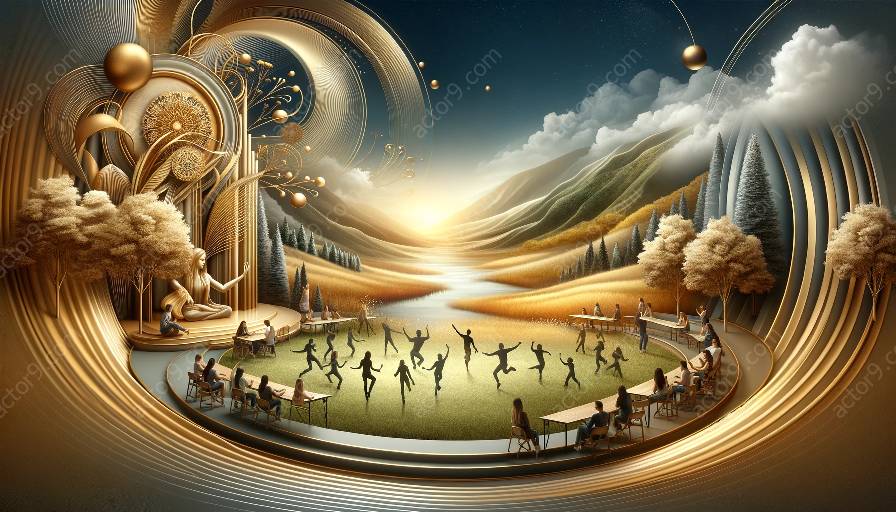Physical theatre has emerged as a powerful tool in educational settings, promoting creativity and innovation among students. By integrating physical theatre into academic environments, educators can unlock new avenues for inspiring students and cultivating their imaginative faculties. This topic cluster explores the impact and benefits of physical theatre in fostering creativity and innovation in education.
Understanding Physical Theatre
Physical theatre is a form of performance that emphasizes the use of the body as a means of storytelling and expression. It often combines elements of dance, acrobatics, mime, and other movement-based techniques to convey narratives and evoke emotions. In educational contexts, physical theatre serves as a dynamic platform for engaging students, encouraging them to explore their physicality, emotions, and creativity.
The Role of Physical Theatre in Education
When introduced in academic environments, physical theatre offers a multi-dimensional approach to learning, transcending traditional classroom methods. By incorporating physicality into educational activities, students can break free from conventional academic constraints and tap into their innate creativity. Physical theatre in education provides a holistic experience that integrates bodily expression with cognitive processes, fostering a deeper understanding of subject matter and promoting innovative thinking.
Stimulating Creativity and Innovation
Physical theatre stimulates creativity and innovation by challenging students to think outside the box and explore unconventional modes of expression. Through physical engagement and improvisation, individuals can discover unique solutions to problems, develop critical thinking skills, and enhance their capacity for innovation. Furthermore, by immersing students in theatrical experiences that demand collaboration and inventive thinking, physical theatre cultivates a culture of innovation within academic environments.
Enhancing Expressive Abilities
One of the key benefits of physical theatre in education is its ability to enhance students' expressive abilities. By encouraging them to communicate and convey narratives through movement and gestures, physical theatre empowers students to express themselves creatively and develop a deeper connection with their emotions. This enhanced expressiveness extends beyond the realms of performance and can positively impact students' communication skills, problem-solving capabilities, and overall innovative potential.
Encouraging Interdisciplinary Learning
Physical theatre fosters a dynamic and interdisciplinary approach to learning, bridging the gap between various academic disciplines and promoting collaboration across different fields of study. Through physical theatre activities, students can explore connections between the arts, humanities, and sciences, resulting in a more integrated and innovative academic experience.
Promoting Confidence and Resilience
Participation in physical theatre instills a sense of confidence and resilience in students, as they learn to push their boundaries, embrace vulnerability, and adapt to new challenges. This newfound confidence and resilience are essential components of a creative and innovative mindset, empowering students to approach academic pursuits with a greater sense of self-assuredness and adaptability.
Cultivating Empathy and Emotional Intelligence
Physical theatre encourages students to explore and embody diverse perspectives, fostering empathy and emotional intelligence. By engaging with different characters, narratives, and physical experiences, students develop a deeper understanding of human emotions and behaviors, thereby nurturing their capacity for empathy and innovative thinking. This heightened emotional intelligence can significantly impact students' creativity and innovation in academic settings, as they become more attuned to the nuances of human interaction and expression.
Empowering Educators as Creative Facilitators
By integrating physical theatre into educational curricula, educators can leverage its transformative potential to become creative facilitators, inspiring students to embrace creativity and innovation in their academic pursuits. Physical theatre empowers educators to design immersive learning experiences that transcend traditional teaching methods, creating a fertile ground for cultivating inventive thinking and self-expression among students.
Conclusion
Physical theatre has the remarkable ability to foster creativity and innovation in academic environments, enriching the educational journey for students and educators alike. By embracing physical theatre in education, institutions can harness the power of embodied expression, interdisciplinary learning, and emotional intelligence to cultivate a generation of creative and innovative thinkers poised to tackle the challenges of tomorrow. Through its multifaceted impact on expressive abilities, confidence, empathy, and collaborative spirit, physical theatre stands as a transformative force in shaping the future of education, inspiring individuals to push the boundaries of creativity and innovation.




































